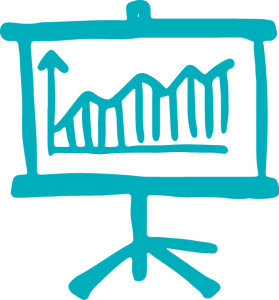Corporate coaching is a key strategy to develop and retain strong leaders across the organization. In a 2012 survey to HR executives, 65 percent rated coaching as a highly effective talent development tool.* Companies are leveraging coaching to prepare the next-generation of executive leadership, hone skills of high-impact functional managers and retain key employees. Corporate coaching programs are growing in scale in terms of number of employees, geographies, and scope.
But let’s be honest, coaching isn’t cheap. The average cost of an external coaching engagement is around $2,500 per month. Furthermore, coaching programs are administratively heavy, adding more costs to coaching programs. Coaching needs to produce clear results. Organizations are left to wonder how they can start, manage, and measure effective coaching programs for an increasing number of employees across multiple locations.
This is where software can play a key part. Below are five growing pains of running and scaling corporate coaching programs. If you have any of these issues, it is time to consider investing in software automation to drive your coaching program effectiveness to the next level.
 1. Management by spreadsheets is not cutting it.
1. Management by spreadsheets is not cutting it.
A lot goes on behind the scenes to make coaching programs effective in the long term. These programs require attention and care with careful results tracking. The trusty tools of Excel and Word for managing multiple programs with multiple participants will only get you so far. By the time you reach just 50 participants, administrators can spend hours hand-matching participants, checking in on engagements, and generating reports back to departmental managers.
Using a software platform simplifies the administration of coaching programs. Admins can automate time-consuming tasks like matching and create workflows. Software can also automate the reporting on the engagement health and the achievement of milestones, sending alerts if there are any issues. Finally, easy-to-run software can generate reports on results and send them to program stakeholders.
The net effect? Software will reduce the time, effort, and cost of running corporate coaching programs while keeping all of the program stakeholders in the loop on the effort and outcomes.
2. Matching the right coach to the situation.
HR professionals understand it is essential to find the right coach for the situation. As in any profession, coaches have different skill sets and are good at certain things. Some are perfect at helping leaders develop their management styles or drive organizational change, still others are perfect for taking new managers and getting them up to speed fast.
Software enables organizations to leverage matching tools to find the perfect coach for the situation. Starting with the development needs of a particular employee, administrators or managers can find coaches using a wide variety of parameters from location to specialization.
Today, real-world reviews are vital pieces of feedback in predicting future success. Make sure to select a system that also offers coach rating surveys to participants, enabling your coaches to be rated and categorized based on specialization and effectiveness.
 3. Gee – I wish I’d known we already had a coach for that!
3. Gee – I wish I’d known we already had a coach for that!
For large organizations with multiple locations, coaching often becomes an island activity. Different locations use different coaching resources that all teach skills independently, leading to inconsistent training throughout your organization. Additionally, great experts abound, but may be captive to just one location or within one department. The rest of the organization misses out on that one valuable coaching resource.
Using software to build a pool of reviewed and categorized coaches leads to greater efficiencies. Software enables you to leverage your coaching assets across the organization according to specialty and coaching fit. Administrators can avoid sourcing new coaches each and every time, freeing them up for other more important tasks. Above all, by leveraging your best resources company-wide, you can ensure a consistency of training for greater success in learning that translates to lasting positive organizational change.
4. Managing coaching contracts and charge-backs gives you a headache.
Companies that use a pool of external, professional coaches know this story too well. Various coaches charge different prices and with distinct contract requirements. On top of this, internal charge-back models to functional groups add another level of management. Keeping track of everything is like herding cats.
Using software can help you manage all of this. Tie contracts to coaches, coaches to engagements, and engagements to results. Software can give you full visibility throughout the entire coaching program lifecycle to see where your efficiencies are (or are not) for future improvements.
5. You “have a feeling” corporate coaching is effective, but aren’t really sure.

Coaching program software can provide insight into many ROI parameters:
- Program goals and milestones – Software helps you map these out ahead of time. Plan where you’re going so you know when you get there. Just like good driving directions.
- The health of the engagement – Are coaches and employees meeting the program milestones? Is the program progressing within the expected timeline? Or is it drawing out, requiring additional time and expense? Software can track milestones and generate alerts when programs get off track so that you can make money-saving improvements, faster.
- Results reporting – Track what the employee learned, program completion dates, and upload these results to your employee’s record on your HR management system.
- Feedback– Did the coach feel the employee learned the material? Did the employee feel like he or she learned it as well? How would the employee rate the coach? Above all, did the manager feel that the employee’s performance improved as expected? An online survey tool will help you discover, compile, and analyze these results so that you can make informed decisions going forward.
- Program cost tracking – It is forever a challenge to charge back the cost of coaching to the right department, to the right division, in the right location, especially if it’s a shared coaching resource. Using a software program for cost tracking and management can greatly assist in this effort. Rather than lumping the total cost of the program together for all participants, it’s possible to track costs by individuals or groups, ensuring an accurate cost is reflected in the department’s budget.
Software is not for everyone. If your program is small with just a few participants, keep it simple. However for organizations that need to scale the number of programs, number of participants, even the number of locations, software can go a long way in saving time, cost, and effort to help you efficiently manage and analyze your coaching engagements.
*Sherpa Coaching Annual Coaching Survey 2012
Download our “How Coaching & Mentoring Can Drive Success in Your Organization” whitepaper

 1. Management by spreadsheets is not cutting it.
1. Management by spreadsheets is not cutting it. 3. Gee – I wish I’d known we already had a coach for that!
3. Gee – I wish I’d known we already had a coach for that!